Germany Prefabricated Houses Market Size
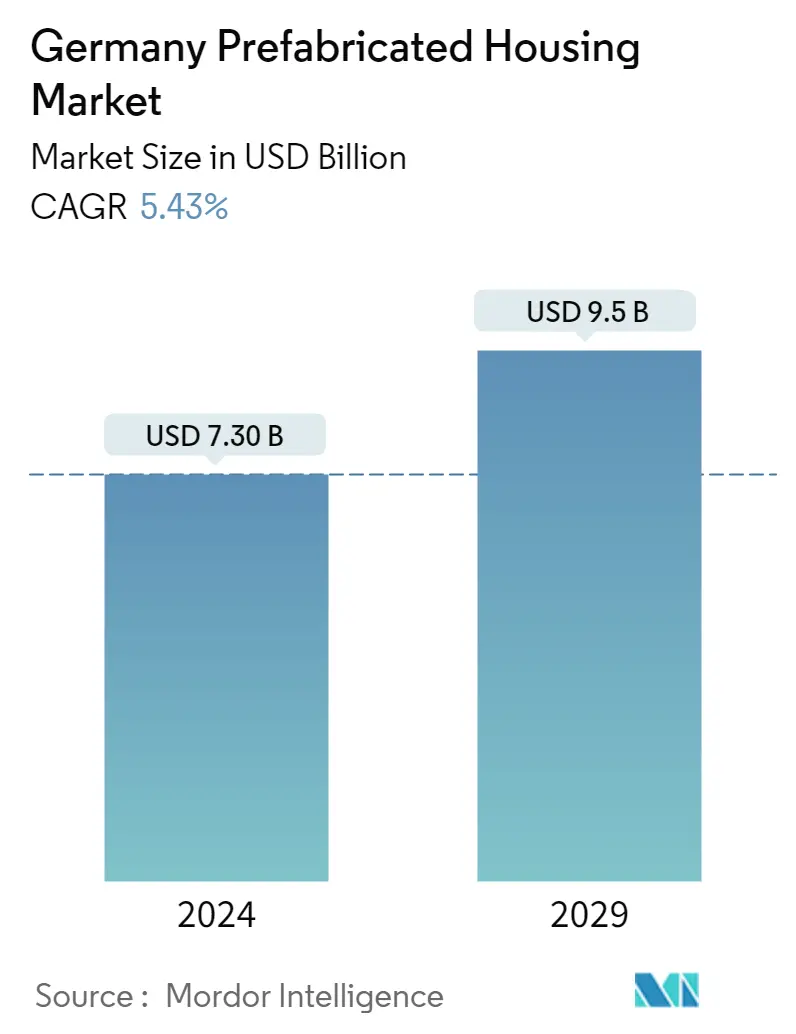
| Study Period | 2020 - 2029 |
| Base Year For Estimation | 2023 |
| Market Size (2024) | USD 7.30 Billion |
| Market Size (2029) | USD 9.50 Billion |
| CAGR (2024 - 2029) | 5.43 % |
| Market Concentration | Low |
Major Players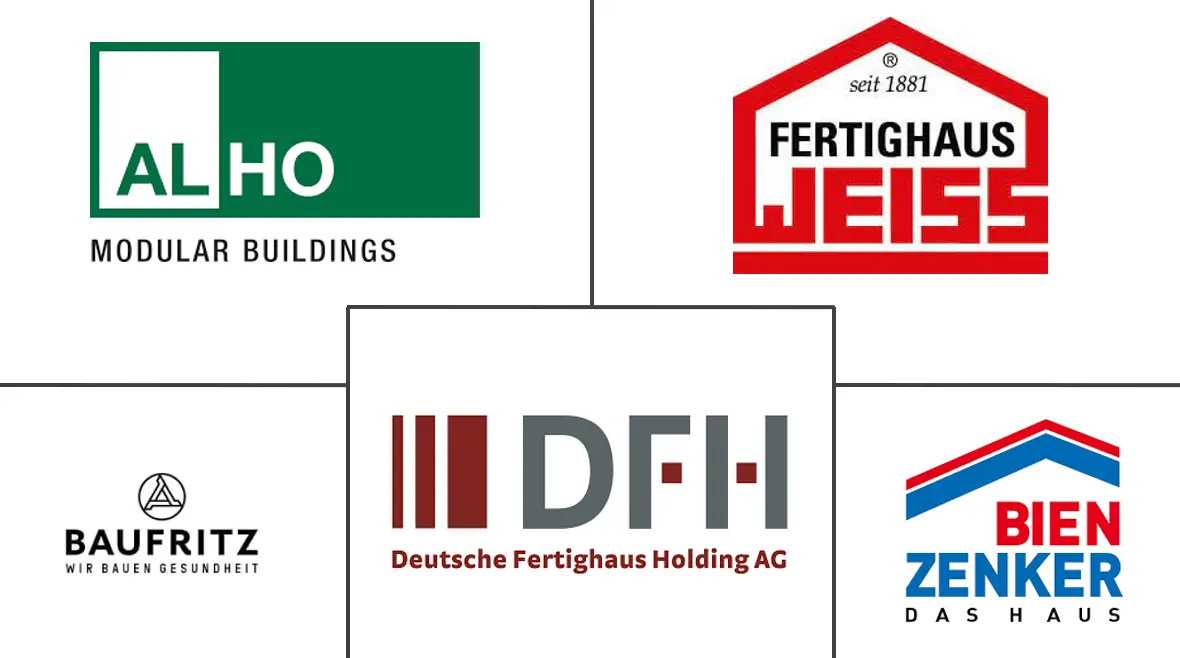
*Disclaimer: Major Players sorted in no particular order |
Germany Prefabricated Houses Market Analysis
The Germany Prefabricated Housing Market size is estimated at USD 7.30 billion in 2024, and is expected to reach USD 9.5 billion by 2029, growing at a CAGR of 5.43% during the forecast period (2024-2029).
- The COVID-19 pandemic slightly impacted the prefabricated housing market in Germany. Due to COVID-19 restrictions, many construction projects were delayed or canceled. However, despite the pandemic, 5,564 prefabricated houses were approved in Q1 2020, 12.8% more than in the same period last year. The overall market grew by just 2.1% to 24,108 newly approved one- and two-family houses.
- The rise in the overall construction industry and increasing prices are contributing to the increasing turnover of the prefabricated housing industry in Germany. In 2022, along with the general boom in residential construction in the country, the share of prefabricated housing solutions in residential construction increased, standing at more than 23%. Additionally, the high demand for turnkey or prefabricated houses and energy-efficient buildings contributes to the market's growth.
- Meanwhile, an increasing labor shortage is another factor driving the prefab construction role in the German residential market. In addition, industry experts say that modular production, coupled with modern digital processes, offers the opportunity to build a faster and more efficient structure while saving resources at the same time.
- In 2022, Saint-Gobain Germany acquired Brüggemann, a company specializing in the production of prefabricated wood-based solutions, to provide a complete range of sustainable solutions in the country. Thus, growing labor shortages, construction costs, and increasing concern about sustainability may drive prefabricated housing in Germany.
Germany Prefabricated Houses Market Trends
This section covers the major market trends shaping the Germany Prefabricated Housing Market according to our research experts:
Prefabricated Buildings are Witnessing Significant Growth
Prefabrication construction has been growing over the past few years, with more than 30% penetration of prefabs in the country compared to the United States. In addition, Germany is utilizing prefabrication to renovate outdated apartments and achieve net zero targets. One of the German factories is utilizing robots to assemble panels and mold them to fit precisely over the walls of an old apartment building. These panels have built-in insulation, which helps the building reduce energy usage significantly.
The renovation of the old building is gaining traction in the country, posing a major challenge in achieving net zero transitions. In addition, many outdated, inefficient buildings, which are a major source of global climate emissions, are driving prefab retrofitting in the country. In 2022, a German start-up named Ecoworks created a new system that takes a 3D scan of an old building, both inside and out, and creates a digital twin of the structure. This digital twin expedites the prefab panels manufacturing as per the requirement.
In addition, the factory produced prefab panels, including windows, ventilation, and channels for pipes. Also, manufacturers provide modular roofs with built-in solar panels, which can be installed in less than 20 minutes and convert the entire building into energy-efficient structures free from fossil fuels. Thus, the sustainability goals set by the country are driving prefab adoption. In 2021, there were more than 334,000 tons of prefabricated buildings (whether complete or already assembled), at a growth rate of 5% compared to the previous year.
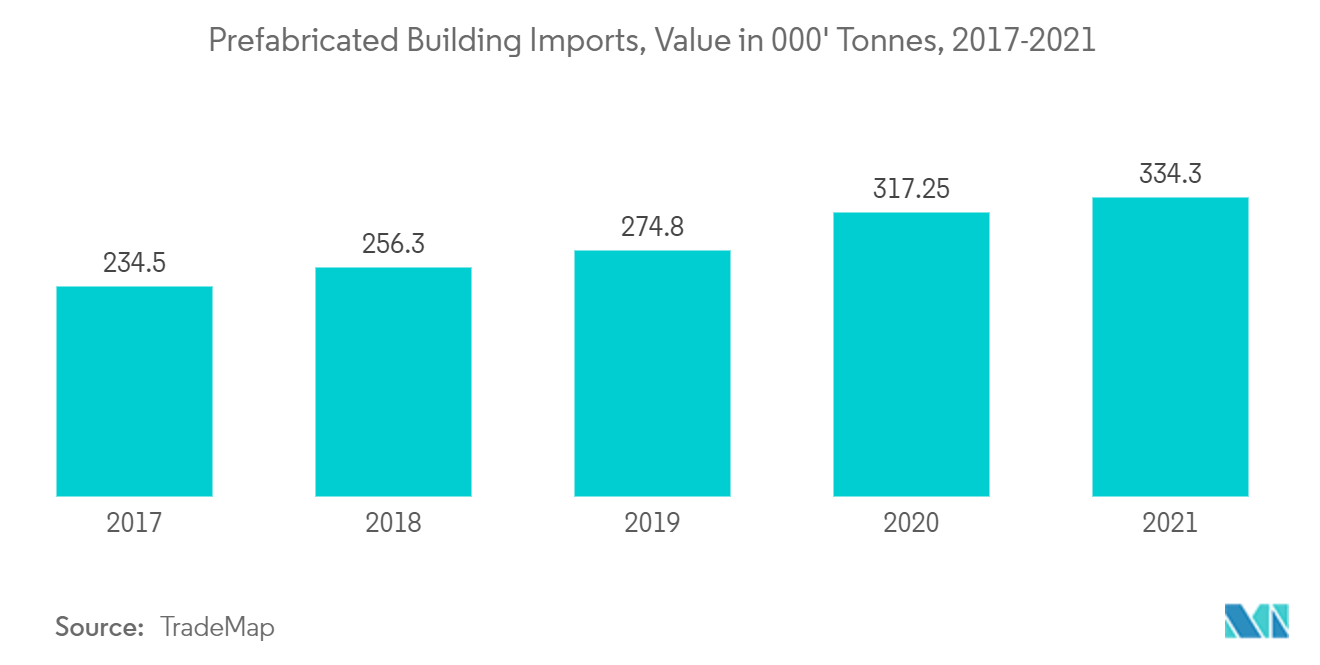
Increasing Costs of Construction Driving the Market
The residential building construction costs continuously rose in Germany, driven by high international demand. In addition, construction material prices are spiking in the country due to limited transportation capacities. In November 2021, according to the Federal Statistical Office statistics, conventional residential building construction witnessed a growth rate of 14.4% compared to the same month in the previous year. The rising costs of conventional construction are driving the adoption of prefabricated structures in the country.
The major reason behind the construction prices spiking was the rise in prices of building materials. In January 2022, wood, steel, and insulation materials became expensive compared to the previous year. In addition, in terms of structural work, the prices for carpentry and wood construction witnessed a growth rate of more than 38%. Additionally, roofing and roof waterproofing (17%), plumbing (16%), and concrete work (16%) rose significantly.
The high demand for land and shortage of materials are also increasing construction costs. Currently, prices are growing more sharply than in over five decades. In addition, most of the construction and civil engineering companies experienced supply shortages. Thus, the supply shortages in construction materials and rising costs are fuelling the prefab structure market in the country.
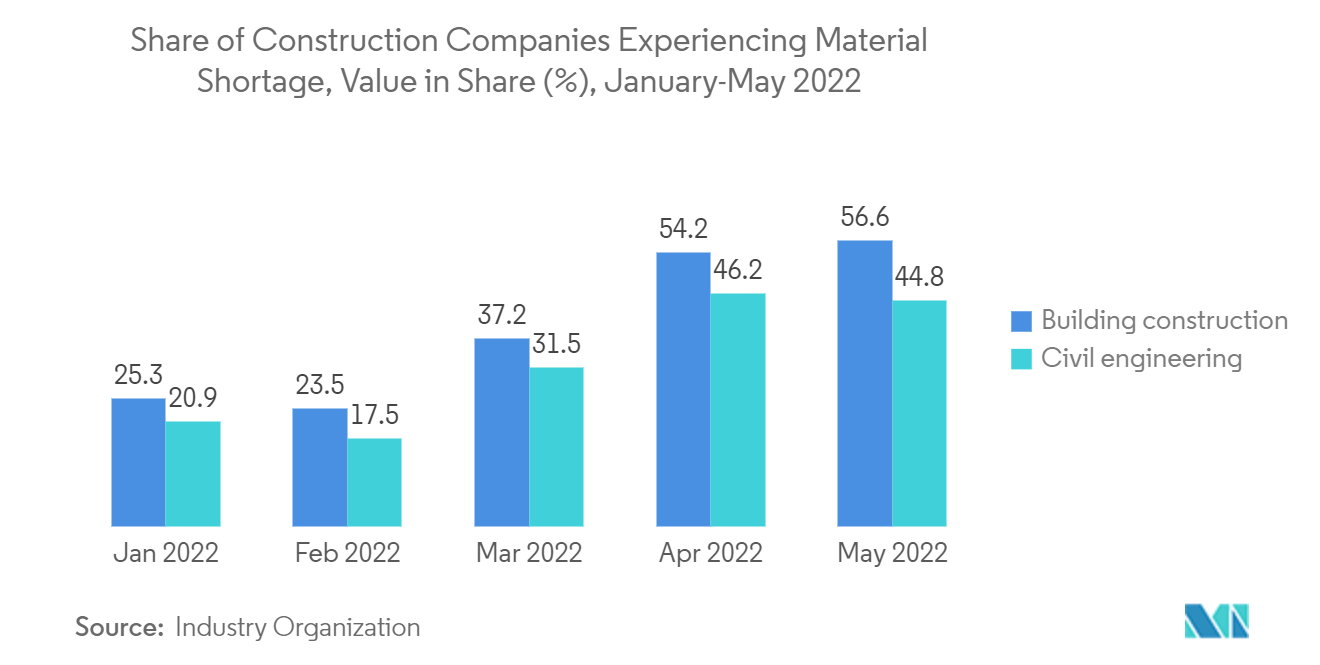
Germany Prefabricated Houses Industry Overview
The prefab housing market in Germany is fragmented, with several international and domestic companies operating in the prefab housing market. The market is expected to grow during the forecast period due to the increase in the prefabricated housing construction investments and upcoming major projects in the country. Major players are Deutsche Fertighaus Holding, Bien Zenker, ALHO Systembau GmbH, Baufritz, and Fertighaus Weiss GmbH.
Germany Prefabricated Houses Market Leaders
-
Deutsche Fertighaus Holding
-
Bien Zenker
-
ALHO Systembau GmbH
-
Baufritz
-
Fertighaus Weiss GmbH
*Disclaimer: Major Players sorted in no particular order
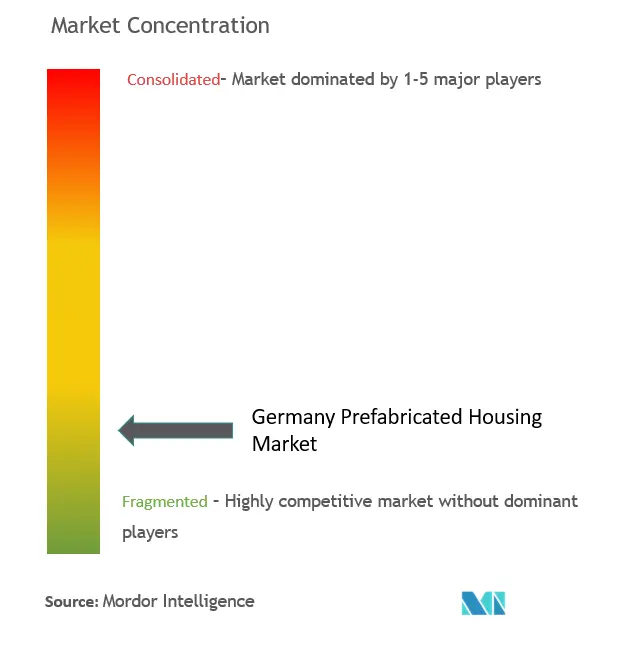
Germany Prefabricated Houses Market News
November 2022: Bien-Zenker, one of the largest manufacturers of prefabricated houses in Europe, planned to open its newest model house in Bad Vilbel in December 2022. This house will show the company's 360° sustainability strategy.
February 2022: DFH Group, manufacturers of prefabricated houses in Germany, began construction work of the DFH Performance and Innovation Center (LIZ) in the Simmern Industrial Park. The facility is spread across 32,000 square meters of area. This facility will be used as the training center, including a test hall and conference area.
Germany Prefabricated Houses Market Report - Table of Contents
1. INTRODUCTION
- 1.1 Study Assumptions
- 1.2 Scope of the Study
2. RESEARCH METHODOLOGY
- 2.1 Analysis Methodology
- 2.2 Research Phases
3. EXECUTIVE SUMMARY
4. MARKET INSIGHTS
- 4.1 Current Market Scenario
- 4.2 Insights on Technological Trends
- 4.3 Insights on Supply Chain/Value Chain Analysis of the Prefabricated Housing Industry
- 4.4 Cost Structure Analysis of the Prefabricated Housing Industry
- 4.5 Insights on Different Types of Materials Used in Prefabricated Housing Construction
- 4.6 Impact of COVID-19 on the Market
5. MARKET DYNAMICS
- 5.1 Drivers
- 5.2 Restraints
- 5.3 Opportunities
-
5.4 Porter's Five Forces Analysis
- 5.4.1 Bargaining Power of Suppliers
- 5.4.2 Bargaining Power of Consumers/Buyers
- 5.4.3 Threat of New Entrants
- 5.4.4 Threat of Substitute Products
- 5.4.5 Intensity of Competitive Rivalry
6. MARKET SEGMENTATION
-
6.1 By Type
- 6.1.1 Single-family
- 6.1.2 Multi-family
7. COMPETITIVE LANDSCAPE
- 7.1 Overview
-
7.2 Company Profiles
- 7.2.1 Deutsche Fertighaus Holding
- 7.2.2 Bien Zenker
- 7.2.3 ALHO Systembau GmbH
- 7.2.4 Baufritz
- 7.2.5 Fertighaus Weiss GmbH
- 7.2.6 Huber & Sohn
- 7.2.7 Luxhaus
- 7.2.8 Regnauer Fertigbau GmbH
- 7.2.9 Daiwa House Modular Europe Ltd
- 7.2.10 Budenbender Hausbau GmbH
- 7.2.11 Living Haus*
- *List Not Exhaustive
8. MARKET OPPORTUNITIES AND FUTURE TRENDS
9. APPENDIX
- 9.1 Marcroeconomic Indicators (GDP Breakdown by Sector, Contribution of Construction to Economy, etc.)
- 9.2 Key Production, Consumption, Exports, and Import Statistics of Construction Materials
Germany Prefabricated Houses Industry Segmentation
Prefabricated homes, often referred to as prefab homes, are primarily manufactured in advance off-site, then delivered and assembled on-site. This report covers market insights, such as market dynamics, drivers, restraints, opportunities, technological innovation, its impact, Porter's five forces analysis, and the impact of COVID-19 on the market. In addition, the report provides company profiles to understand the competitive landscape of the market.
Germany's prefabricated housing market is segmented by type (single-family and multi-family). The report offers market size and forecasts in value (USD billion).
| By Type | Single-family |
| Multi-family |
Germany Prefabricated Houses Market Research FAQs
How big is the Germany Prefabricated Housing Market?
The Germany Prefabricated Housing Market size is expected to reach USD 7.30 billion in 2024 and grow at a CAGR of 5.43% to reach USD 9.50 billion by 2029.
What is the current Germany Prefabricated Housing Market size?
In 2024, the Germany Prefabricated Housing Market size is expected to reach USD 7.30 billion.
Who are the key players in Germany Prefabricated Housing Market?
Deutsche Fertighaus Holding, Bien Zenker, ALHO Systembau GmbH, Baufritz and Fertighaus Weiss GmbH are the major companies operating in the Germany Prefabricated Housing Market.
What years does this Germany Prefabricated Housing Market cover, and what was the market size in 2023?
In 2023, the Germany Prefabricated Housing Market size was estimated at USD 6.92 billion. The report covers the Germany Prefabricated Housing Market historical market size for years: 2020, 2021, 2022 and 2023. The report also forecasts the Germany Prefabricated Housing Market size for years: 2024, 2025, 2026, 2027, 2028 and 2029.
Prefabricated Homes in Germany Industry Report
Statistics for the 2023 Prefabricated Homes in Germany market share, size and revenue growth rate, created by Mordor Intelligence™ Industry Reports. Prefabricated Homes in Germany analysis includes a market forecast outlook to 2029 and historical overview. Get a sample of this industry analysis as a free report PDF download.



